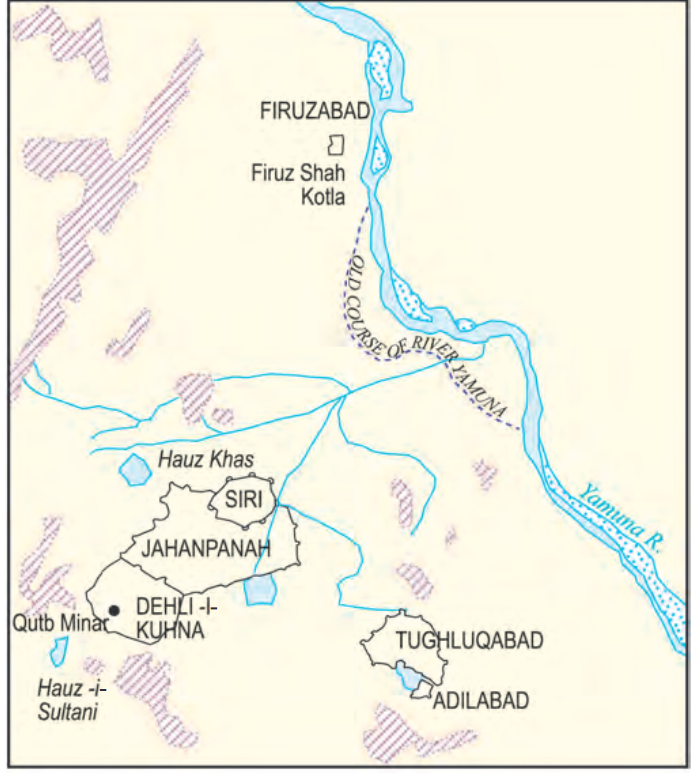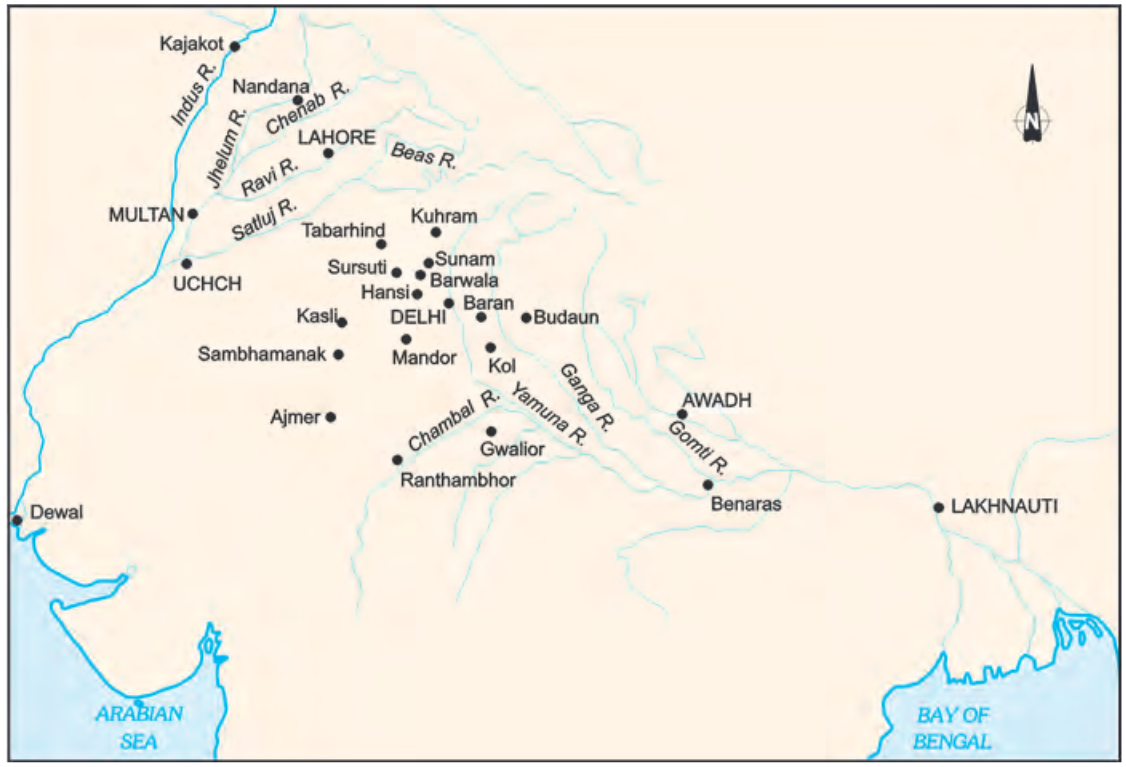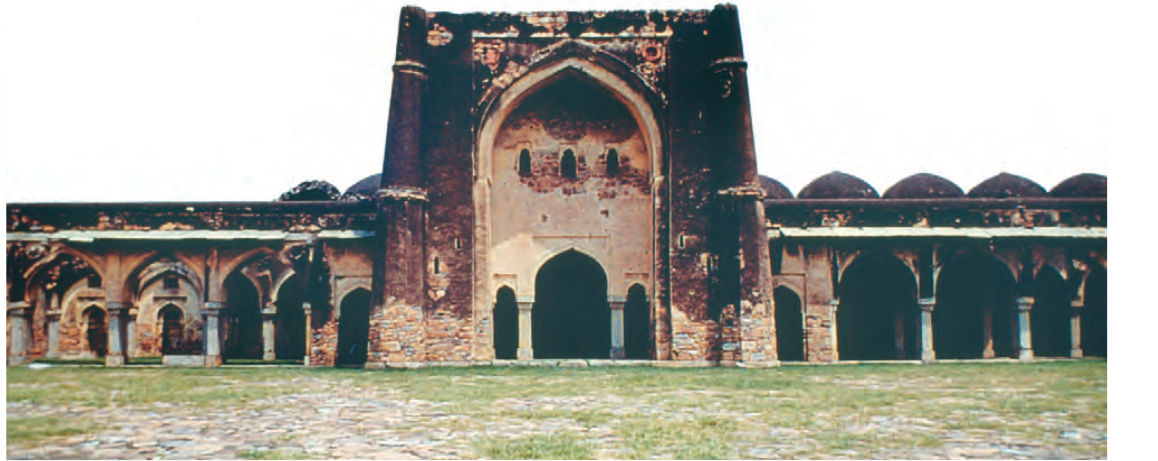Table of Contents
3
THE DELHI SULTANS

In Chapter 2 we saw that regions like the Kaveri delta became the centre of large kingdoms. Did you notice that there was no mention of a kingdom with Delhi as its capital? That was because Delhi became an important city only in the twelfth century.
Take a look at Table 1. Delhi first became the capital of a kingdom under the Tomara Rajputs, who were defeated in the middle of the twelfth century by the Chauhans (also referred to as Chahamanas) of Ajmer. It was under the Tomaras and Chauhans that Delhi became an important commercial centre. Many rich Jaina merchants lived in the city and constructed several temples. Coins minted here, called dehliwal, had a wide circulation.

Map 1
Selected Sultanate cities of Delhi, thirteenth-fourteenth centuries.
The transformation of Delhi into a capital that controlled vast areas of the subcontinent started with the foundation of the Delhi Sultanate in the beginning of the thirteenth century. Take a look at Table 1 again and identify the five dynasties that together made the Delhi Sultanate.
The Delhi Sultans built many cities in the area that we now know as Delhi. Look at Map 1 and locate Dehli-i Kuhna, Siri and Jahanpanah.
THE RULERS OF DELHI
Table 1
RAJPUT DYNASTIES



Firuz Shah Tughluq’s tomb
Finding Out about the Delhi Sultans
Although inscriptions, coins and architecture provide a lot of information, especially valuable are “histories”, tarikh (singular)/tawarikh (plural), written in Persian, the language of administration under the Delhi Sultans.

Fig.1
Four stages in the making of a manuscript:
A. Preparing the paper.
B. Writing the text.
C. Melting gold to highlight important words and passages.
D. Preparing the binding.
The authors of tawarikh were learned men: secretaries, administrators, poets and courtiers, who both recounted events and advised rulers on governance, emphasising the importance of just rule.
Do you think the circle of justice is an appropriate term to describe the relationship between the king and his subjects?
Fakhr-i Mudabbir wrote in the thirteenth century:
A king cannot survive without soldiers. And soldiers cannot live without salaries. Salaries come from the revenue collected from peasants. But peasants can pay revenue only when they are prosperous and happy. This happens when the king promotes justice and honest governance.
Keep the following additional details in mind: (1) the authors of tawarikh lived in cities (mainly Delhi) and hardly ever in villages. (2) They often wrote their histories for Sultans in the hope of rich rewards. (3) These authors advised rulers on the need to preserve an “ideal” social order based on birthright and gender distinctions. Their ideas were not shared by everybody.
Birthright
Privileges claimed on account of birth. For example, people believed that nobles inherited their rights to govern, because they were born in certain families.
Gender distinctions
Social and biological differences between women and men. Usually, these differences are used to argue that men are superior to women.
In 1236 Sultan Iltutmish’s daughter, Raziyya, became Sultan. The chronicler of the age, Minhaj-i Siraj, recognised that she was more able and qualified than all her brothers. But he was not comfortable at having a queen as ruler. Nor were the nobles happy at her attempts to rule independently. She was removed from the throne in 1240.
Minhaj-i Siraj thought that the queen’s rule went against the ideal social order created by God, in which women were supposed to be subordinate to men. He therefore asked: “In the register of God’s creation, since her account did not fall under the column of men, how did she gain from all of her excellent qualities?”
On her inscriptions and coins Raziyya mentioned that she was the daughter of Sultan Iltutmish. This was in contrast to the queen Rudramadevi (1262-1289), of the Kakatiya dynasty of Warangal, part of modern Andhra Pradesh. Rudramadevi changed her name on her inscriptions and pretended she was a man. Another queen, Didda, ruled in Kashmir (980-1003). Her title is interesting: it comes from “didi” or “elder sister”, an obviously affectionate term given to a loved ruler by her subjects.
Express Minhaj’s ideas in your own words. Do you think Raziyya shared these ideas? Why do you think it was so difficult for a woman to be a ruler?
From Garrison Town to Empire: The Expansion of the Delhi Sultanate

Map 2
Major cities captured by Shamsuddin Iltutmish.
In the early thirteenth century the control of the Delhi Sultans rarely went beyond heavily fortified towns occupied by garrisons. The Sultans seldom controlled the hinterland of the cities and were therefore dependent upon trade, tribute or plunder for supplies.
Hinterland
The lands adjacent to a city or port that supply it with goods and services.
Controlling garrison towns in distant Bengal and Sind from Delhi was extremely difficult. Rebellion, war, even bad weather could snap fragile communication routes. Delhi’s authority was also challenged by Mongol invasions from Afghanistan and by governors who rebelled at any sign of the Sultan’s weakness. The Sultanate barely survived these challenges. Its consolidation occurred during the reign of Ghiyasuddin Balban and further expansion under Alauddin Khalji and Muhammad Tughluq.
Garrison town
A fortified settlement, with soldiers.
The first set of campaigns along the “internal frontier” of the Sultanate aimed at consolidating the hinterlands of the garrison towns. During these campaigns forests were cleared in the Ganga-Yamuna doab and hunter-gatherers and pastoralists expelled from their habitat. These lands were given to peasants and agriculture was encouraged. New fortresses, garrison towns and towns were established to protect trade routes and to promote regional trade.
The second expansion occurred along the “external frontier” of the Sultanate. Military expeditions into southern India started during the reign of Alauddin Khalji (see Map 3) and culminated with Muhammad Tughluq. In their campaigns, Sultanate armies captured elephants, horses and slaves and carried away precious metals.
By the end of Muhammad Tughluq’s reign, 150 years after somewhat humble beginnings, the armies of the Delhi Sultanate had marched across a large part of the subcontinent. They had defeated rival armies and seized cities. The Sultanate collected taxes from the peasantry and dispensed justice in its realm. But how complete and effective was its control over such a vast territory?

Map 3
Alauddin Khalji’s campaign into south India.

Fig. 2
Quwwat al-Islam mosque and minaret, built during the last decade of the twelfth century. This was the congregational mosque of the first city built by the Delhi Sultans, described in the chronicles as Dehli-i- Kuhna (the old city). The mosque was enlarged by Iltutmish and Alauddin Khalji. The minar was built by two Sultans: Qutbuddin Aybak and Iltutmish.
The Masjid
A mosque is called a masjid in Arabic, literally a place where a Muslim prostrates in reverence to Allah. In a “congregational mosque” (masjid-i-jamior jama masjid) Muslims read their prayers (namaz) together. Members of the congregation choose the most respected, learned male as their leader (imam) for the rituals of prayer. He also delivers the sermon (khutba) during the Friday prayer.
During prayer, Muslims stand facing Mecca. In India this is to the west. This is called the qibla.

Fig. 3
Begumpuri mosque, built in the reign of Muhammad Tughluq, was the main mosque of Jahanpanah, the “Sanctuary of the World”, his new capital in Delhi. See Map 1.
The Delhi Sultans built several mosques in cities all over the subcontinent. These demonstrated their claims to be protectors of Islam and Muslims. Mosques also helped to create the sense of a community of believers

Fig. 4
Moth ki Masjid, built in the reign of Sikandar Lodi by his minister .
who shared a belief system and a code of conduct. It was necessary to reinforce this idea of a community because Muslims came from a variety of backgrounds.

Fig. 5
Mosque of Jamali Kamali, built in the late 1520s .
Compare Figures 2, 3, 4 and 5. What similarities and differences do you notice amongst the mosques? The mosques in Figures 3, 4 and 5 show an evolution in architectural tradition that culminates in Shah Jahan’s mosque in Delhi (see Fig. 7 in Chapter 5).
A Closer Look: Administration and Consolidation under the Khaljis and Tughluqs
The consolidation of a kingdom as vast as the Delhi Sultanate needed reliable governors and administrators. Rather than appointing aristocrats and landed chieftains as governors, the early Delhi Sultans, especially Iltutmish, favoured their special slaves purchased for military service, called bandagan in Persian. They were carefully trained to man some of the most important political offices in the kingdom. Since they were totally dependent upon their master, the Sultan could trust and rely upon them.
Slaves rather than sons
The Sultans were advised:
A slave, whom one has brought up and promoted, must be looked after for it needs a whole lifetime and good luck to find a worthy and experienced slave. Wise men have said that a worthy and experienced slave is better than a son …
Can you think of any reason why a slave would be better than a son?
The Khaljis and Tughluqs continued to use bandagan and also raised people of humble birth, who were often their clients, to high political positions. They were appointed as generals and governors. However, this also introduced an element of political instability.
Client
Someone who is under the protection of another; a dependent or hanger-on.
Slaves and clients were loyal to their masters and patrons, but not to their heirs. New Sultans had their own servants. As a result the accession of a new monarch often saw conflict between the old and the new nobility. The patronage of these humble people by the Delhi Sultans also shocked many elites and the authors of Persian tawarikh criticised the Delhi Sultans for appointing the “low and base-born” to high offices.
Officials of Sultan Muhammad Tughluq
Sultan Muhammad Tughluq appointed Aziz Khummar, a wine distiller, Firuz Hajjam, a barber, Manka Tabbakh, a cook, and two gardeners, Ladha and Pira, to high administrative posts. Ziyauddin Barani, a mid-fourteenth-century chronicler, reported their appointments as a sign of the Sultan’s loss of political judgement and his incapacity to rule.
Why do you think Barani criticised the Sultan?
Like the earlier Sultans, the Khalji and Tughluq monarchs appointed military commanders as governors of territories of varying sizes. These lands were called iqta and their holder was called iqtadar or muqti. The duty of the muqtis was to lead military campaigns and maintain law and order in their iqtas. In exchange for their military services, the muqtis collected the revenues of their assignments as salary. They also paid their soldiers from these revenues. Control over muqtis was most effective if their office was not inheritable and if they were assigned iqtas for a short period of time before being shifted. These harsh conditions of service were rigorously imposed during the reigns of Alauddin Khalji and Muhammad Tughluq. Accountants were appointed by the state to check the amount of revenue collected by the muqtis. Care was taken that the muqti collected only the taxes prescribed by the state and that he kept the required number of soldiers.
As the Delhi Sultans brought the hinterland of the cities under their control, they forced the landed chieftains – the samanta aristocrats – and rich landlords to accept their authority. Under Alauddin Khalji the state brought the assessment and collection of land revenue under its own control. The rights of the local chieftains to levy taxes were cancelled and they were also forced to pay taxes. The Sultan’s administrators measured the land and kept careful accounts. Some of the old chieftains and landlords served the Sultanate as revenue collectors and assessors. There were three types of taxes: (1) on cultivation called kharaj and amounting to about 50 per cent of the peasant’s produce, (2) on cattle and (3) on houses.
It is important to remember that large parts of the subcontinent remained outside the control of the Delhi Sultans. It was difficult to control distant provinces like Bengal from Delhi and soon after annexing southern India, the entire region became independent. Even in the Gangetic plain there were forested areas that Sultanate forces could not penetrate. Local chieftains established their rule in these regions. Sometimes rulers like Alauddin Khalji and Muhammad Tughluq could force their control in these areas but only for a short duration.
Chieftains and their fortifications
Ibn Battuta, a fourteenth-century traveller from Morocco, Africa, explained that chieftains sometimes
fortified themselves in mountains, in rocky, uneven and rugged places as well as in bamboo groves. In India the bamboo is not hollow; it is big. Its several parts are so intertwined that even fire cannot affect them, and they are on the whole very strong. The chieftains live in these forests which serve them as ramparts, inside which are their cattle and their crops. There is also water for them within, that is, rain water which collects there. Hence they cannot be subdued except by powerful armies, who entering these forests, cut down the bamboos with specially prepared instruments.
Describe the ways in which the chieftains arranged for their defence.
The Mongols under Genghis Khan invaded Transoxiana in north-east Iran in 1219 and the Delhi Sultanate faced their onslaught soon after. Mongol attacks on the Delhi Sultanate increased during the reign of Alauddin Khalji and in the early years of Muhammad Tughluq’s rule. This forced the two rulers to mobilise a large standing army in Delhi which posed a huge administrative challenge. Let us see how the two Sultans dealt with this.
In this list of Muhammad Tughluq’s failures we sometimes forget that for the first time in the history of the Sultanate, a Delhi Sultan planned a campaign to capture Mongol territory. Unlike Alauddin’s defensive measures, Muhammad Tughluq’s measures were conceived as a part of a military offensive against the Mongols.
The Sultanate in the Fifteenth and Sixteenth Centuries
Take a look at Table 1 again. You will notice that after the Tughluqs, the Sayyid and Lodi dynasties ruled from Delhi and Agra until 1526. By then, Jaunpur, Bengal, Malwa, Gujarat, Rajasthan and the entire south India had independent rulers who established flourishing states and prosperous capitals. This was also the period which saw the emergence of new ruling groups like the Afghans and the Rajputs.
Some of the states established in this period were small but powerful and extremely well administered. Sher Shah Sur (1540-1545) started his career as the manager of a small territory for his uncle in Bihar and eventually challenged and defeated the Mughal emperor Humayun (1530-1540, 1555-1556). Sher Shah captured Delhi and established his own dynasty. Although the Sur dynasty ruled for only fifteen years (1540-1555), it introduced an administration that borrowed elements from Alauddin Khalji and made them more efficient. Sher Shah’s administration became the model followed by the great emperor Akbar (1556-1605) when he consolidated the Mughal Empire.
ELSEWHERE
The “Three Orders”, the “Peace of God”,
Knights and the Crusades
The idea of the “Three Orders” was first formulated in France in the early eleventh century. It divided society into three classes: those who prayed, those who fought, and those who tilled the land. This division of society into “Three Orders” was supported by the Church to consolidate its dominant role in society. This helped the emergence of a new warrior group called Knights.
The Church patronised this group and used them to propagate their idea of “Peace of God”. The attempt was to direct warriors away from conflict amongst themselves and send them instead on a campaign against the Muslims who had captured the city of Jerusalem. This led to a series of campaigns called the Crusades. These campaigns in the service of God and the Church completely altered the status of Knights. Originally, these Knights did not belong to the class of nobles. But by the end of the eleventh century in France, and a century later in Germany, the humble origins of these warriors were forgotten. By the twelfth century, nobles also wanted to be known as Knights.
 Imagine
Imagine
You are a peasant in Alauddin Khalji’s or Muhammad Tughluq’s reign and you cannot pay the taxes demanded by the Sultan. What will you do?
KEYWORDS
iqta
tarikh
garrison
Mongols
gender
kharaj
Let’s recall
1. Which ruler first established his or her capital at Delhi?
2. What was the language of administration under the Delhi Sultans?
3. In whose reign did the Sultanate reach its farthest extent?
4. From which country did Ibn Battuta travel to India?
Let’s understand
5. According to the “circle of justice”, why was it important for military commanders to keep the interests of the peasantry in mind?
6. What is meant by the “internal” and “external” frontiers of the Sultanate?
7. What were the steps taken to ensure that muqtis performed their duties? Why do you think they may have wanted to defy the orders of the Sultans?
8. What was the impact of the Mongol invasions on the Delhi Sultanate?
Let’s discuss
9. Do you think the authors of tawarikh would provide information about the lives of ordinary men and women?
10. Raziyya Sultan was unique in the history of the Delhi Sultanate. Do you think women leaders are accepted more readily today?
11. Why were the Delhi Sultans interested in cutting down forests? Does deforestation occur for the same reasons today?
Let’s do
12. Find out whether there are any buildings built by the Delhi Sultans in your area. Are there any other buildings in your area that were built between the twelfth and fifteenth centuries? Describe some of these buildings, and draw sketches of them.
